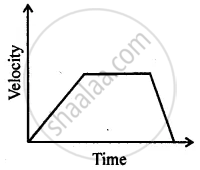Advertisements
Advertisements
प्रश्न
A cheetah starts from, rest, and accelerates at 2 m/s2 for 10 seconds. Calculate :
(a) the final velocity
(b) the distance travelled.
उत्तर
We have to find the distance travelled by the cheetah. We have the following information given,
So, initial velocity, (u) = 0 m/s
Acceleration, (a) = 2 m/s2
Time taken, (t) = 10 s
(a) So, we can find the final velocity using the relation, v = u + at
Final velocity,
v = 0 + (2) (10)
= 20 m/s
(b) We can calculate the distance travelled by cheetah using the 2nd equation of motion,
`s = ut + 1/2 at^2`
Put the values in above equation to find the distance travelled
`(s) = 0(10) + 1/2(2)(10)^2`
= 100 m
APPEARS IN
संबंधित प्रश्न
A bus decreases its speed from 80 km h−1 to 60 km h−1 in 5 s. Find the acceleration of the bus.
What term is used to denote the change of velocity with time ?
A freely falling object travels 4.9 m in 1st second, 14.7 m in 2 nd second, 24.5 m in 3rd second, and so on. This data shows that the motion of a freely falling object is a case of :
When a car driver travelling at a speed of 10 m/s applies brakes and brings the car to rest in 20 s, then retardation will be :
The slope of a speed-time graph gives:
Define velocity. State its unit.
If a stone and a pencil are dropped simultaneously in vacuum from the top of a tower, then which of the two will reach the ground first? Give reason.
State how the velocity-time graph can be used to find
The acceleration of a body
For a uniformly retarded motion, the velocity-time graph is _____________
Can you suggest a real-life example about the motion of a body from the following velocity – time graph?

